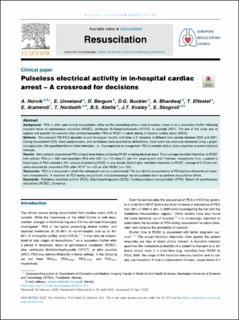| dc.contributor.author | Norvik, Anders | |
| dc.contributor.author | Unneland, Eirik | |
| dc.contributor.author | Bergum, Daniel | |
| dc.contributor.author | Buckler, D.G. | |
| dc.contributor.author | Bhardwaj, A. | |
| dc.contributor.author | Eftestøl, Trygve Christian | |
| dc.contributor.author | Aramendi, E. | |
| dc.contributor.author | Nordseth, Trond | |
| dc.contributor.author | Abella, B.S. | |
| dc.contributor.author | Kvaløy, Jan Terje | |
| dc.contributor.author | Skogvoll, Eirik | |
| dc.date.accessioned | 2023-03-23T09:35:31Z | |
| dc.date.available | 2023-03-23T09:35:31Z | |
| dc.date.created | 2022-10-10T19:57:14Z | |
| dc.date.issued | 2022 | |
| dc.identifier.citation | Norvik, A., Unneland, E., Bergum, D., Buckler, D. G., Bhardwaj, A., Eftestøl, T., ... & Skogvoll, E. (2022). Pulseless electrical activity in in-hospital cardiac arrest–A crossroad for decisions. Resuscitation, 176, 117-124. | en_US |
| dc.identifier.issn | 0300-9572 | |
| dc.identifier.uri | https://hdl.handle.net/11250/3060059 | |
| dc.description.abstract | Background
PEA is often seen during resuscitation, either as the presenting clinical state in cardiac arrest or as a secondary rhythm following transient return of spontaneous circulation (ROSC), ventricular fibrillation/tachycardia (VF/VT), or asystole (ASY). The aim of this study was to explore and quantify the evolution from primary/secondary PEA to ROSC in adults during in-hospital cardiac arrest (IHCA).
Methods
We analyzed 700 IHCA episodes at one Norwegian hospital and three U.S. hospitals at different time periods between 2002 and 2021. During resuscitation ECG, chest compressions, and ventilations were recorded by defibrillators. Each event was manually annotated using a graphical application. We quantified the transition intensities, i.e., the propensity to change from PEA to another clinical state using time-to-event statistical methods.
Results
Most patients experienced PEA at least once before achieving ROSC or being declared dead. Time average transition intensities to ROSC from primary PEA (n = 230) and secondary PEA after ASY (n = 72) were 0.1 per min, peaking at 4 and 7 minutes, respectively; thus, a patient in these types of PEA showed a 10% chance of achieving ROSC in one minute. Much higher transition intensities to ROSC, average of 0.15 per min, were observed for secondary PEA after VF/VT (n = 83) or after ROSC (n = 134).
Discussion
PEA is a crossroad in which the subsequent course is determined. The four distinct presentations of PEA behave differently on important characteristics. A transition to PEA during resuscitation should encourage the resuscitation team to continue resuscitative efforts. | en_US |
| dc.language.iso | eng | en_US |
| dc.publisher | Elsevier | en_US |
| dc.rights | Navngivelse 4.0 Internasjonal | * |
| dc.rights.uri | http://creativecommons.org/licenses/by/4.0/deed.no | * |
| dc.title | Pulseless electrical activity in in-hospital cardiac arrest – A crossroad for decisions | en_US |
| dc.type | Peer reviewed | en_US |
| dc.type | Journal article | en_US |
| dc.description.version | publishedVersion | en_US |
| dc.rights.holder | The authors | en_US |
| dc.subject.nsi | VDP::Medisinske Fag: 700 | en_US |
| dc.source.pagenumber | 117-124 | en_US |
| dc.source.volume | 176 | en_US |
| dc.source.journal | Resuscitation | en_US |
| dc.identifier.doi | 10.1016/j.resuscitation.2022.04.024 | |
| dc.identifier.cristin | 2060228 | |
| cristin.ispublished | true | |
| cristin.fulltext | original | |
| cristin.qualitycode | 2 | |

